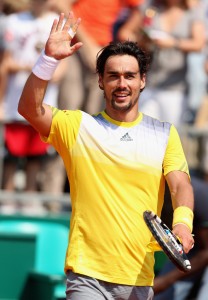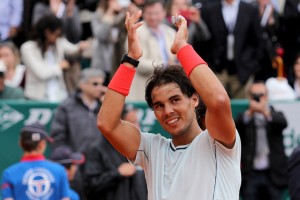Monte Carlo, Semifinals
(1) Djokovic d. Fognini, 6/2 6/1
It seems magnificently unfair that Fabio Fognini should look the way he does while being a highly-ranked professional tennis player. It’s unfair on the many actors who’ll never look like that, no matter how much they’ll spend on cosmetic procedures.
It’s unfair on his poor fellow-pros who toil day after day on the practice court, yet won’t ever be able do the things Fognini seemingly does on a whim. (As I write this he has casually held to love, comprehensively outfoxing and out-stroking Novak Djokovic.) But most of all it’s unfair on those of us who’ll never look like that, and never strike a tennis ball half so well, but who are cursed to write about those who do.
It’s a badly kept secret that those who can merely turn phrases, even as we labour to turn them until they trip, skitter and catch the light, feel an abiding envy towards those who effortlessly turn heads. It is an envy nourished by the sad discovery that even the most serious writers spend all their time thinking about those who in return barely think about them, and abetted by the queasy realisation, which usually comes at night, that the seductive pleasures of the depths might add up to less than the undoubted thrills of the surface. And even though we might console ourselves that the turning heads are empty, there’s usually enough evidence to the contrary to suggest the consolation itself is hollow. Deep down, I’d probably give it all up to be Fognini. Or maybe not so deep down.
For a while we have comforted ourselves that the Italian’s head, at least as regards tennis, didn’t have that much in it either. Despite all the talent in the world, his middling ranking attested to a crippling lack of mental fortitude. The Italian has never won a tour title, despite several excellent opportunities to do so last year, and has thoroughly earned his reputation for losing interest once he falls behind. He is always the first to make the assessment that he cannot win, whereupon he works hard to make it true. His general air of strutting insouciance attains a haughty grandiloquence as he tosses aside handfuls of unwanted points. Lazy narratives attach themselves to particular players, and they are very hard to dislodge, partly because Il Gattopardo doesn’t change its spots, but also because those who talk about tennis can grow complacent. Tales of wasted talent are the easiest to tell.
Now we may have to find a different tale. Fognini defeated a pair of top ten players en route to the last four in Monte Carlo, remaining poised, focussed and professional throughout. Suddenly, he is ranked well within the top thirty, a lofty status which brings with it all the attendant respectability of a French Open seeding. No longer will he be a dangerous floater, an inspired wastrel ruining a serious player’s day. I confess it doesn’t feel quite right.
On the other hand, Fognini in the semifinals of a Masters event did feel right. That it happened in Monte Carlo felt entirely appropriate. He is made for tennis along the Mediterranean, although he would doubtless be better suited to an earlier, more permissive era. It is no stretch to envisage Fognini as a Lothario prowling the sun-drenched claycourts of the bygone Riviera. Once again, deep down, the sensation is one of envy, mixed with a piquant nostalgia for an era when a pure stylist might attain the heights of the sport, when even the best played tennis as though there was more to it than winning.
Alas, befogged nostalgia is all it is. In this era, more than any other, one sooner or later collides with an entirely modern reality. The modern reality is usually incarnated in one of the big four, and the collision is invariably catastrophic. That game that Fognini held to love might have been delightful, but it certainly wasn’t pivotal. The entirely modern Djokovic had already broken once to open the set, and would break again to seal it. He broke a few more times to win the second set, and thus the match. The romance of the old world had encountered the stark reality of the new, and it was like witnessing a cavalry unit charging a Panzer division.
There were naturally moments of pure Fognini brilliance, but Djokovic was perfectly ruthless in never allowing them to join up into something meaningful. A benevolent dictator, the Serb will permit dissent but not resistance. This is almost always the case when the great players face Fognini. Fully aware of his penchant for theatre, they use the scoreboard to stifle his opportunity to create drama. There’s not much more to add. The whole thing was over very quickly; under sixty minutes. Although there is great theatre that takes less than an hour, none of it occurs on a tennis court.
(3) Nadal d. (6) Tsonga, 6/3 7/6
Rafael Nadal, another aspect of modern tennis reality, had earlier finished off Jo Wilfried Tsonga in straight sets, although his eagerness to do so quickly and therefore avoid unnecessary drama was undone by an audacious late change from the Frenchman. The Spaniard has now reached his ninth consecutive Monte Carlo final, despite being the overwhelming favourite to do so. Earlier in the week he was asked about this matter himself, he was unsurprisingly quick to disavow his favouritism.  I wish someone would explain the concept to him, but really it hardly matters. Fortunately, favouritism isn’t a matter of opinion, and isn’t something the players get to choose for themselves, although this obvious point does not deter the assembled media from endlessly pestering them about it. Thankfully the betting market had long since made up its own mind, and so Nadal remained virtually unbackable.
I wish someone would explain the concept to him, but really it hardly matters. Fortunately, favouritism isn’t a matter of opinion, and isn’t something the players get to choose for themselves, although this obvious point does not deter the assembled media from endlessly pestering them about it. Thankfully the betting market had long since made up its own mind, and so Nadal remained virtually unbackable.
Tsonga began aggressively, and to be honest he never really eased up. His failures, once he’d unluckily failed to break at 2/1 in the first set, were entirely of execution and focus, rather than of intent. Simply put, he began to play awfully, to a level that I hadn’t truly believed a top-ten player could play at. It is hard to believe that that simple failure to break serve was so decisive, given that he’d been playing well until then. It was almost, dare I say it, Fognini-like.
Conditions, admittedly, were difficult: unseasonably cold with a strong swirling breeze, although the sun was out. Nadal, for the most part directed the ball safely between the lines, lofting it over the net with ample air. Faced with a rapidly disintegrating opponent, he was entirely right to do this. But it was by no means interesting. The Spaniard finished the set with five winners to four unforced errors, which was at least a dozen less errors than Tsonga, who managed a heroic 16% of points behind his second serve.
The match continued to stagger down the same path in the second set, with Tsonga broken straight away, and Nadal eventually moving to 5/1. Having learned his lesson in the first set, Tsonga had now won precisely zero points behind his second serve. From there the defending champion’s standard did not alter appreciably, while the conditions remained unchanged. Yet somehow, at the uttermost end, Tsonga for no good reason rediscovered his form. He broke Nadal back twice, saving four match points in total, and eventually forced an unlikely tiebreak. Sadly, at 3-4 Tsonga’s capacity to make sound decisions once more deserted him, first with an ill-considered backhand up the line, then with a pointlessly risky slice that curved into the tramlines, but that would have yielded him no advantage had it landed in. Nadal sealed the match with a bold series of forehands, capped by a winner.
In the end a semifinal that looked like being a perfunctory blowout achieved a small measure of interest, although I’d be overstating the case to say it achieved more than that. Social media inevitably told a different tale, although the tale was mostly told by Nadal fans who don’t realise that almost coming close to dropping a set isn’t the same as losing a match. In the end their man faced no set points. Indeed, I don’t recall that Tsonga ever came within three points of winning the set. A similar, if more fraught, scene had played out yesterday, when Nadal defeated an inspired Grigor Dimitrov in the quarterfinals. Dimitrov did actually take a set, and made it to 4/4 in the decider, although he never came especially close to a match point, or even a break point.
The narrative that has coiled about Nadal is that of the unstoppable warrior, battling against impossible odds to achieve desperate victories, defying his own crippled body, hordes of blood-thirsty foes, and the very gods themselves. Through this snakes the sub-narrative of his innate fragility – that his form is only ever contingent on a perfect mental state and ideal conditions. (You should have heard people go on about the effect of the weather yesterday, as though cold damp coastal claycourts are Dimitrov’s ideal operating environment, somehow placing Nadal at a crucial disadvantage, which he then heroically overcame.)
These narratives are fatuous. The reality is that Nadal wins the overwhelming majority of his matches in straight sets, even when he isn’t at his best, just like the other top players, who often aren’t at their best, either. For almost a decade he has defeated almost every other tennis player on the planet in every kind of weather on any surface, regardless of his prevailing form. (The last time he lost in Monte Carlo, Federer hadn’t yet won a Major. To put it into a broader global perspective, the first year Nadal won here, in 2005, Youtube didn’t exist.) He does that because he is a very, very good modern tennis player. Tomorrow he’ll face another very, very good modern tennis player in Djokovic. As baffling as it sounds, the markets have installed Nadal, eight-time defending champion and arguably the best claycourter of all time, as the clear favourite. Yet another thing he’ll have to overcome.

6 Responses to Deep Down